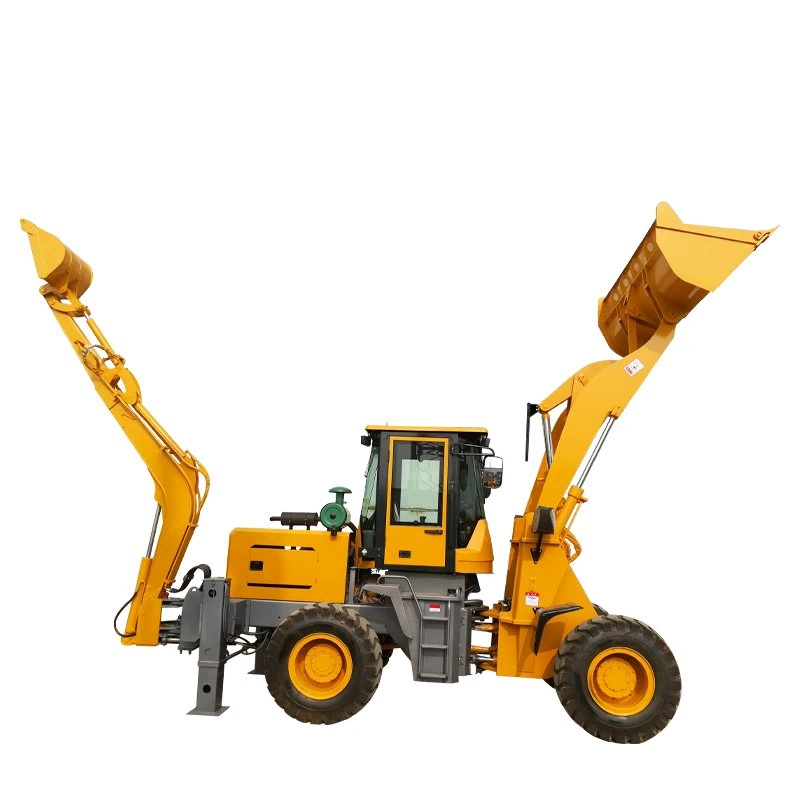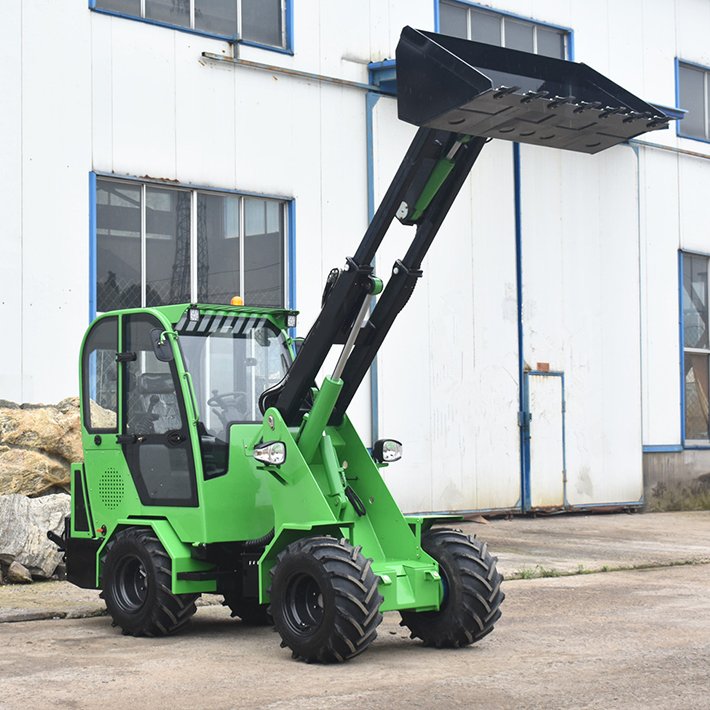The difference between a backhoe loader and other loaders: In the fields of construction, agriculture, and various engineering operations, backhoe loaders, skid-steer loaders, and wheel loaders are all common mechanical equipment. Although they are all related to material handling and earthwork operations, there are significant differences in their designs, functions, and application scenarios.
Table of Contents
ToggleI. Structural Design Differences
Backhoe Loaders: The uniqueness of backhoe loaders lies in their “front – and – rear – design. The front end is equipped with a loader bucket for conventional material loading and handling, such as sand, gravel, and soil. At the rear, there is a backhoe attachment, which is similar to the working arm of a small excavator and can be used for excavation, trenching, and other fine-grained operations. This front-and-rear combination structure enables the backhoe loader to achieve two different main functions on one piece of equipment, resembling a combination of a tractor and a small excavator-loader. In addition, the backhoe part can usually rotate at a certain angle, generally up to 180 degrees, enhancing its operational flexibility.
Skid-steer Loaders: Skid-steer loaders are known for their compact and flexible structures. They have a relatively small body, usually with four-wheel drive, and the spacing between the four wheels is relatively narrow. Their working devices are directly installed at the front of the vehicle body and are operated through a hydraulic system. The most significant feature of skid-steer loaders is their ability to turn in place. That is, one side of the wheels rotates forward while the other side rotates backward, allowing them to complete the turning motion in a very small space. This characteristic gives them extremely high mobility in narrow and crowded work sites.
Wheel Loaders: Wheel loaders have a relatively large body size and a high ground clearance. They are mainly composed of a power system, frame, traveling device, working device, etc. The working device is a large bucket located at the front end, connected to the frame through a series of linkage mechanisms, and the lifting and tilting of the bucket are controlled by a hydraulic system. Wheel loaders have relatively large and fewer tires, usually four, to provide strong load-bearing capacity and driving stability, adapting to various complex construction site road conditions.

II. Functional Feature Differences
Backhoe Loaders: The functional diversity of backhoe loaders is their greatest advantage. The front-end loader bucket can be used for general material loading, short-distance transportation, and site leveling. The rear-end backhoe endows it with the ability to excavate, and it can dig ditches, foundation pits, etc., which is suitable for small-scale construction projects, road repairs, and rural infrastructure construction. For example, in a small-scale street drainage pipeline laying project, the backhoe loader can first use the front-end bucket to clean up the debris on the site surface, and then use the rear-end backhoe to dig a trench with the appropriate depth and width for the pipeline laying.
Skid steer Loaders: Although the bucket capacity of skid-steer loaders is relatively small, they are highly flexible. They can move freely in small spaces, and carry out material loading, handling, and some simple excavation work. In addition, skid-steer loaders can quickly replace different working attachments, such as forks, breaker hammers, snowplows, etc., to adapt to a variety of different operation requirements. For example, in an indoor renovation and demolition project, a skid-steer loader equipped with a breaker hammer can break the walls in a limited space. In winter, after installing a snowplow attachment, it can quickly clear the snow on the road.
Wheel Loaders: Wheel loaders are known for their strong loading and transportation capabilities. Their large buckets can load a large amount of materials at one time, and they have a high lifting height and dumping distance. Wheel loaders perform well in large open-pit mines, large-scale construction sites, etc. They can quickly load excavated ores, earth, and stone materials onto transport vehicles, achieving efficient material transfer. At the same time, with their good driving performance, they can also carry out long-distance material transportation within the construction site.

III. Application Scenario Differences
Backhoe Loaders: Due to their comprehensive functions and moderate size, backhoe loaders are often used in urban infrastructure maintenance, small-scale construction projects, and rural construction. In cities, they can be used for the cleaning and excavation of roadside ditches, the foundation construction of small-scale buildings, etc. In rural areas, they can be used for the construction of farmland water conservancy facilities and rural road construction. For example, when building an irrigation canal in the countryside, a backhoe loader can easily complete the excavation of the canal and the sorting of the surrounding earthwork.
Skid-steer Loaders: Skid-steer loaders are mainly applied in working environments with limited space, such as indoor construction sites, narrow streets, and warehouses. In urban old-city renovation projects, the narrow streets and alleys make it difficult for large-scale equipment to enter. At this time, skid-steer loaders can give full play to their advantages of being flexible and compact, and complete material loading, unloading, and handling work. In addition, in some small-scale projects with high requirements for operation accuracy, such as micro-terrain shaping in landscape construction and the demolition of small-scale buildings, skid-steer loaders can also show their strengths with their multi-functional attachments and flexible operation.
Wheel Loaders: Wheel loaders are mainly active in large-scale industrial sites and infrastructure construction projects. In large open-pit coal mines, wheel loaders are responsible for quickly loading the mined coal onto large-scale transport trucks to ensure the efficient transportation of coal. In highway construction sites, they can transport a large amount of sand, gravel, earth, and stone materials from the material yard to the designated construction site, providing sufficient material supply for road sub-base paving. Their high-efficiency loading and transportation capabilities make them indispensable equipment in large-scale engineering construction.

If you are still not sure how to choose a loader, then contact our HIXEN team and we will provide you with a solution.
